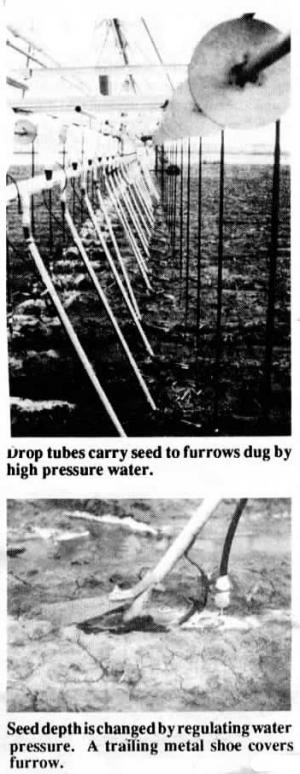1990 - Volume #14, Issue #2, Page #28
[ Sample Stories From This Issue | List of All Stories In This Issue | Print this story
| Read this issue]
Irrigation Planter
 |
The Mobile Irrigation Planting System, or MIPS, uses a stream of high-pressure water to dig a furrow, and then places the seed and covers it. It can also inject sub-surface fertilizer while planting.
MIPS has been tested for the past two years by Dr. Bill Lyle and James P. Bordovsky, ag engineers at the Texas experiment station near Plainview, and has so far been used for planting corn, cotton, wheat and grain sorghum.
"It eliminates compaction during planting and fertilizing and has the potential to be the best planting system ever in heavy residue conditions," says Lyle, noting that four patents have already been applied for on the first-of-its-kind system.
Seed is suspended in a water-trapping gel and is carried under pressure down a line that's separate from the main irrigation supply to drop tubes on the individual row units. Pressurized manifolds have accumulators that look like upside down pop bottles to ensure even seed distribution the length of the irrigator. Seed can be placed at different depths, depending on water pressure which ranges from 5 to 50 psi. A separate nozzle injects fertilizer as deep as 8 to 10 in. using high pressure. A flat trailing "shoe" covers the seed right behind the seed tube. During planting the irrigator moves at just 1/2 to 1 ft. per minute.
Lyle's prototype system is installed on a linear irrigator, although he says it will work fine on a center pivot. One problem with installing the system on an irrigator is that they're designed to stop and start as they move across the field. In order to use the system to plant, the machine must be set up to keep moving without stopping. Lyle had to design new electronic variable frequency controls to keep the system moving continuously.
Lyle says other researchers have tried "seedigation" in the past but says it's never worked well because seed is placed on the soil surface. "We think this is the system of the future with the potential to eliminate all trips over the field except for harvest," says Lyle, noting however that there are still bugs to work out of the system before it's ready for market. Some irrigation systems, for example, may have to be reinforced to handle the extra equipment.
Contact: FARM SHOW Followup, Dr. Bill Lyle, Texas Agricultural Experiment Station, Highway 70, Halfway, Texas/Olton Route, Plainview, Texas 79072 (ph 806 889-3315)

Click here to download page story appeared in.

Click here to read entire issue
To read the rest of this story, download this issue below or click here to register with your account number.




